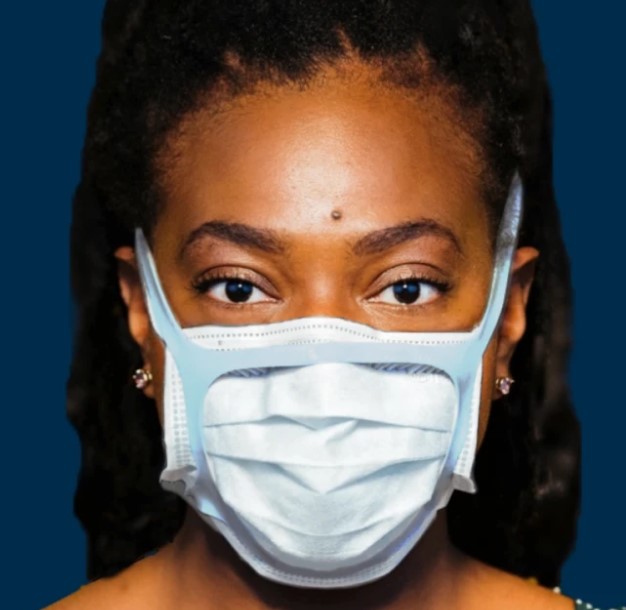
1/ Must read new preprint: Strategies to minimize #SARSCoV2 #COVIDisAirborne transmission -- combined impacts of ventilation and mask effective filtration efficiency. medrxiv.org/content/10.110…
Extensive set up of manikins and analysis of indoor classroom.
Extensive set up of manikins and analysis of indoor classroom.
2/ Key take away @zeynep @ScottGottliebMD @DrTomFrieden @EricTopol @DrEricDing @ASlavitt: we can all upgrade our masks cheaply. Conditional indoor infection probabilities as low as <0.0001 (0.01%) per hour might be reached with the use of surgical masks and mask fitters alone. 

3/ @FixTheMask makes a cheap reusable mask fitter. I use it, it's great. UW invented a DYI Badger fitter. making.engr.wisc.edu/mask-fitter/ but @FixTheMask one tested better. N95-like protection for 26-50 cents per use.
4/ Preprint's p. 67: With the use of a mask fitter, one can achieve an effective filtration efficiency approaching the material filtration efficiency for a mask. @AliNouriPhD
5/ Preprint's p. 66: Inexpensive disposable masks used with a mask fitter can achieve approximately 95% effective filtration efficiency in some cases.
@linseymarr
@ShellyMBoulder
@CorsIAQ
@jljcolorado
@CathNoakes
@ProfCharlesHaas
@kprather88
@PrasadKasibhat1
@Poppendieck
@linseymarr
@ShellyMBoulder
@CorsIAQ
@jljcolorado
@CathNoakes
@ProfCharlesHaas
@kprather88
@PrasadKasibhat1
@Poppendieck
6/ @Don_Milton
From Abstract: conditional probability of infection for three distinct airborne exposure scenarios: (1) an infectious instructor exposing susceptible students; (2) an infectious student exposing other susceptible students; @j_g_allen and
From Abstract: conditional probability of infection for three distinct airborne exposure scenarios: (1) an infectious instructor exposing susceptible students; (2) an infectious student exposing other susceptible students; @j_g_allen and
7/ (3) an infectious student exposing a susceptible instructor.
8/ Field measurements were performed in a classroom using a polydisperse neutralized salt (NaCl) aerosol, generated in a size range consistent with human-generated SARS-CoV-2 containing bioaerosols, as a safe surrogate.
9/ Measurements included time-resolved and size-resolved NaCl aerosol concentration distributions and size-resolved effective filtration efficiency of different masks with and without mask fitters....
10/ @j_g_allen Wells-Riley model results for the different scenarios suggest that ventilation of a classroom alone is not able to achieve infection probabilities less than 0.01 (1%) for up to 10 ACH and an event duration of one hour.
11/ The use of moderate to high effective filtration efficiency masks by all individuals present, on the other hand, was able to significantly reduce infection probability and
12/ could achieve reductions in infection probability by 5x, 10x, or even >100x dependent on the mask used and use of a mask fitter. This enables conditional infection probabilities <0.1% or even <0.01% to be reached with the use of masks and mask fitters alone.
14/ 1. Particle loss rates for the classroom determined by measurements of air exchange rate for the room match well with those determined from aerosol concentration time evolution in the class room, giving improved confidence in inputs to the well-mixed model.
15/ 2. Based on in situ measurements in a representative classroom with forced air mechanical ventilation, the well-mixed assumption holds to a reasonable approximation (within better than a factor of 2) for the classroom space studied.
16/ 3. Leakage rates around masks are typically in the range of 20-80% when fit reasonably well to the user’s face, resulting in effective filtration efficiencies that are much lower than the material filtration efficiency. @linseymarr @ShellyMBoulder
@jljcolorado
@jljcolorado
17/ 4. With the use of a mask fitter, one can achieve an effective filtration efficiency approaching the material filtration efficiency for a mask. Inexpensive disposable masks used with a mask fitter can achieve approximately 95% effective filtration efficiency in some cases.
18/ 5. Ventilation of spaces with fresh air or well-filtered air is important, ventilation rates greater than > 5 ACH result in only modest additional reductions in infection probability and generally are not merited due to their high cost, energy usage, and increase in…
19/ …noise and room air velocities.
6. With all occupants in the indoor classroom masks, long-range airborne conditional infection probabilities are greatly reduced and reductions of 4x, 10x, or even 100x can be achieved.
6. With all occupants in the indoor classroom masks, long-range airborne conditional infection probabilities are greatly reduced and reductions of 4x, 10x, or even 100x can be achieved.
20/ 7. In certain scenarios, source control, i.e., providing an individual performing a known high emission rate activity with a high effective filtration efficiency mask (using a mask fitter), may be an effective approach to limit long-range airborne infection probabilities.…
21/ …8. Use of masks and ventilation simultaneously are synergistic (providing multiplicative reductions) and together can provide greatly reduced aerosol transmission infection probability.
22/ The conclusions provided here give guidance on the relative effectiveness of ventilation and mask wearing for decreasing long-range airborne infection probabilities.
23/ The results specifically emphasize the large potential for effective mask wearing and improved masks, or use of mask fitters, to greatly reduce infection probabilities.
24/ Please read this thread and preprint:
medrxiv.org/content/10.110…
@CathNoakes
@CorsIAQ
@zeynep
@linseymarr
@ShellyMBoulder
@jljcolorado
@j_g_allen
@DrEricDing
@Bob_Wachter
@EricTopol
@Poppendieck
@ProfCharlesHaas
@kprather88
@PrasadKasibhat1
@Don_Milton
@vfmcneill
@gcmorr
medrxiv.org/content/10.110…
@CathNoakes
@CorsIAQ
@zeynep
@linseymarr
@ShellyMBoulder
@jljcolorado
@j_g_allen
@DrEricDing
@Bob_Wachter
@EricTopol
@Poppendieck
@ProfCharlesHaas
@kprather88
@PrasadKasibhat1
@Don_Milton
@vfmcneill
@gcmorr
See my thread on how to protect yourself, based on this research. Summary: use the @armbrust_usa masks and the @FixTheMask brace to get near N95 fit + filtration. @FixTheMask tested the @armbrust_usa -- 97.7% filtration. Please RT.
https://twitter.com/DavidLKeating/status/1349392567465598984
• • •
Missing some Tweet in this thread? You can try to
force a refresh




